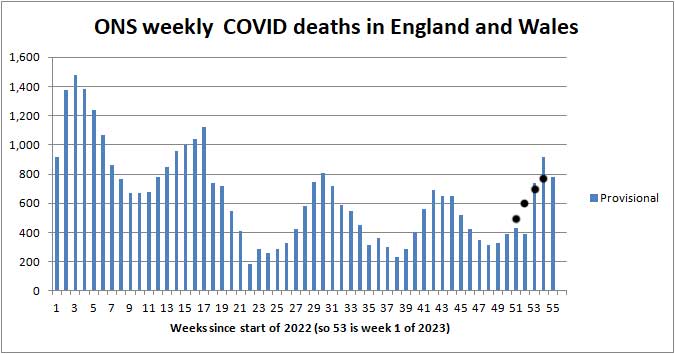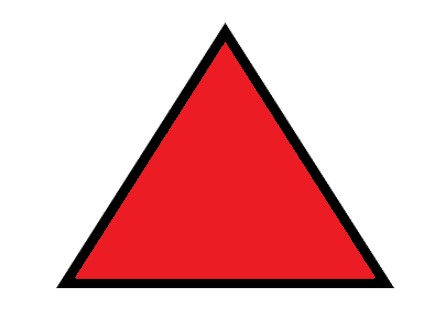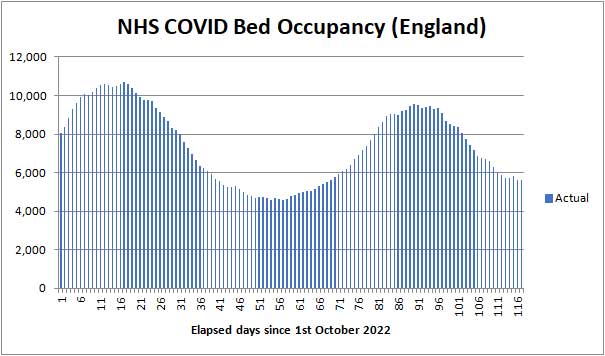
Angus and Rosemary's Miscellany
of Malvern - Other Resources
|
Coronavirus (COVID-19) epidemic weekly update for Malvern SeniorsNew cut down version Click to read our observations on politics and world events 5th February 2023
Get your booster ASAP if you have not already had it Last chance is 12th February 2023 PreambleFor almost three years we have been keeping an eye on the published government figures and monitoring the media to asses the likely level of risk for Seniors in the Malvern Hills district and providing links to where further information could be found. For most people, COVID is no longer a critical threat to health so this a shortened version of our weekly update which will continue to be updated weekly, nominally with Sunday's date, for a few weeks more. ContentsSummaryNow there is no reason for most of us who are fully vaccinated to worry as the Kraken variant of COVID-19 looks set to take hold during February 2023. For the remainder who have been thinking of getting a booster, time is running out as the present offer of the Bivalent Booster expires on Sunday 12th February 2023. If you are still thinking of getting a booster the time to act is in the next few days. In the last week, NHS COVID bed occupancy and daily hospital admissions have begun rising in some regions of England, particularly the South East, while daily deaths continue to remain 'acceptably' low. Independent SAGE say there has been an increase in cases amongst children aged under 11 years and their parents. The majority of COVID patients in hospital continue to be aged over 65 years. Beds occupied by COVID patients continue to be a strain on the NHS, and the situation could get worse in February if cases of the Kraken virus spread rapidly. We speculate the present increase in daily cases is due to the seeding of the Omicron XBB.1.5 variant of COVID-19, dubbed Kraken, which is already sweeping the USA. If confirmed, a Kraken Wave of COVID-19 could sweep through the community during February. Due to evasion of immunity, it's possible many of us will catch the Kraken variant, but expect most to be protected from severe illness by the vaccines, especially those who have had the Bivalent Booster.Symptoms could be little different to a mild cold. Note that NHS England has issued a final call to come forward for a COVID booster which means that Sunday 12th February will be the last chance for those aged 50+ to take up the present offer. Note: further vaccinations for the most vulnerable may be offered in the Spring and/or Autumn (too late to protect against Kraken). What happens if you get sick with COVIDIf you are feeling poorly there is now a fair chance it won't be COVID-19 but some other winter respiratory illness; 'bugs and lurgi' of the unknown variety have recently left friends feeling very poorly, sometimes for two to three weeks. If you have a temperature/fever it's more likely Flu. If you have a stash of Lateral Flow Tests you could test yourself at home. However be aware that a negative test does not guarantee you don't have COVID. Whatever the virus best stay at home until you feel better, and wear a face mask to protect others if you do have to go out. Nowadays, you might not know it's COVID and brush it off as just another cold. The top six symptoms reported through the Zoe app are, sore throat, runny nose, blocked nose, sneezing, headache, and cough. A few of those who have caught COVID report either getting easily tired or suffering from shortness of breath for some weeks afterwards; if so patients are advised to take it easy until fully recovered. A small number of patients report debilitating symptoms for months after so-called recovery especially women. For example see Dez Medinger and Danny Altmann's book The Long COVID Handbook in bibliography. PrecautionsNowadays few people are taking precautions - but that may change if the Kraken virus starts spreading rapidly. Keep that facemask handy during February. Booster shotsIn 2022 an Autumn booster shot was offered to all those aged 50+ years and patients designated Clinically Extremely Vulnerable, such as those with a severely weakened immune system. The last chance to be vaccinated in England under this campaign is Sunday 12th February 2023. At the same time the offer of a third jab to those aged under 50 years is expected to cease. JCVI will advise if further boosters are advisable for persons at higher risk of serious illness in 2023. See Health Secretary's Twitter: https://twitter.com/SteveBarclay/status/1618336060395626524
Vaccination SitesSection deleted; if necessary refer to 2022 archived blogs (see menu of archived pages).
|
| Date report published | Prevalence (England) | Ratio of people with COVID |
| 9th December 2022 | 941,700 | 1:60 |
| 16th December 2022 | 1,095,100 | 1:50 |
| 23rd December 2022 | 1,197,200 | 1:45 |
| 6th January 2023 | 2,463,000 | 1:20 |
| 13th January 2023 | 2,189,300 | 1:25 |
| 20th January 2023 | 1,461,900 | 1:40 |
| 27th January 2023 | 906.300 | 1:60 |
| 3rd February 2023 | 799,200 | 1:70 |
Prevalence of COVID-19 in England estimated by ONS
Prevalence was then estimated 1:80 in Wales; 1:70 in Scotland; and 1:65 in Northern Ireland.
Zoe Health Study
The ZOE Health Study estimates are shown in the following table.
| Date of screenshot | Prevalence (UK) | Estimated new infections per day |
| 5th January 2023 | 3,293,888 | 216,645 |
| 12th January 2023 | 2,960,068 | 169,654 |
| 19th January 2023 | 2,159,096 | 94,762 |
| 26th January 2023 | 1,622,173 | 104,964 |
| 2nd February 2023 | 1,644,925 | 139,405 |
Prevalence of COVID-19 in UK estimated by the Zoe Health Study
According to the more recent Zoe figures, estimated prevalence has levelled off, while daily cases have risen 33% in the last week possibly due to the new Kraken variant.
The increase in daily cases detected by Zoe correlates with Hospital bed occupancy once again turning upwards.
Note: the Zoe numbers were rebased on 3rd February to better align with the ONS numbers, approximately halving the numbers in the table above. The direction of travel remains the same.
| Date of screenshot | Prevalence (UK) | Estimated new infections per day |
| 4th February 2023 | 895,560 | 81,770 |
Rebased Prevalence of COVID-19 in UK estimated by the Zoe Health Study
We will start using the new series of numbers next week.
 Number
of deaths
Number
of deaths
Statistics on COVID deaths are published by Public Health England, The Office of National Statistics, and NHS England. These can't be directly compared as they cover different periods, but together the figures paint a picture of the direction of travel - which is that the daily death rate in real-time probably peaked about 1st January 2023, whereas the delayed ONS figures reported on Tuesdays have only just peaked.
The death rate is expected gradually to fall throughout most of February. ONS figures are currently reporting the 'broad crest of the wave' and deaths are likely to fall faster on the 'downslope' (ie in a week or two).
PHE figures
The Dashboard chart of COVID (28) deaths, following a positive test, by date of death shows that the 7 day average peaked in England at 164 deaths per day around 30th December before falling to 95 deaths per day on 23rd January 2023 (add a further 2 deaths per day for Wales).
The Coronavirus Dashboard chart suggests 30th December roughly marked the peak of Winter Wave deaths.
The PHE figures include people who die with COVID but not from it so are higher than the ONS numbers.
Click to view the UK government Coronavirus Dashboard
ONS figures
The Office of National Statistics (ONS) reports registered deaths in England and Wales where COVID-19 is mentioned somewhere on the death certificate. The ONS figures lag real time by 10 - 14 days due to the administrative delay in submitting and processing reports, and do not include Northern Ireland and Scotland.
Note: the figures include cases where COVID may have been a secondary cause of death.
Click for ONS data on deaths (Excel spreadsheet)
The ONS figures are broken down by Local Authority providing a glimpse of where deaths are occurring. The provisional cumulative total of COVID related deaths in Worcestershire reported by the ONS up to 20th January (week 3 of 2023) is shown below.
Note: the numbers are now derived from Table 1 of the ONS Death Registrations spreadsheet using the in-built filters. This gives the provisional total of deaths registered in any week, which can be distorted by delayed reporting, for example, due to public holidays.
Deaths by Welsh Health Boards are excluded to avoid duplication as these are totals of Local authorities.
Death occurrences by 'date of death' is the most accurate metric but takes longer to be confirmed.
| Districts of Worcs |
Deaths 2020 |
Deaths 2021 |
Deaths 2022 |
Deaths 2023 |
Week 3 | Population |
| Bromsgrove | 164 | 142 | 59 | 8 | 3 | 98,529 |
| Malvern Hills | 61 | 98 | 74 | 5 | 1 | 77,545 |
| Redditch | 108 | 109 | 47 | 4 | 1 | 85,317 |
| Worcester | 87 | 134 | 51 | 1 | 0 | 103,542 |
| Wychavon | 157 | 154 | 85 | 5 | 2 | 126,240 |
| Wyre Forest | 171 | 132 | 62 | 1 | 0 | 100,957 |
| TOTAL | 748 | 769 | 378 | 24 | 7 | 592,130 |
Provisional cumulative COVID-19 deaths in Worcestershire registered by ONS to 20th January 2023.
There were 2 deaths in a care home and 1 in hospital in Bromsgrove; 1 death in a care home in the Malvern Hills; 1 death in hospital in Redditch; and 2 deaths in hospital in Wychavon.
The general picture has been of a continuing handful of weekly deaths in Worcestershire.
In England and Wales 780 COVID-19 related deaths were reported in the week to 20th January, 139 less than the week before and a fall of 15%. Of these 150 were in care homes, 53 at home, 16 in a hospice, 559 in hospital and 2 elsewhere.

ONS provisional deaths 'by week reported' in England and Wales since the start of 2022 (so week 53 is week 1 of 2023)
Note: the black dots indicate roughly what we think the actual figures might be on account of delayed reporting over Christmas and New Year.
This week's chart on the Coronavirus Dashboard for average deaths by date of death appears to have rolled back to 23rd December. So instead, taking the latest ONS figures from table 2, deaths in week 1 of 2023 registered so far are 775, and in week 2 (incomplete) 632.
In comparison averaged over recent years roughly 1,700 people die daily from all causes in the UK, so currently COVID deaths account for about 5% of all deaths.
Many of these are said to be people who die a few months earlier than they might otherwise do. COVID is perhaps an extra burden which pushes the very frail over the edge.
Click for ONS Coronavirus (COVID-19) latest insights: Deaths
NHS England figures
Daily COVID hospital death figures in England show some scatter, but charting them suggests the daily death rate peaked about 1st January 2023 and that the daily death rate has since fallen by about 60%.
NHS England figures for Worcestershire
The table below shows the latest COVID deaths in Worcestershire hospitals reported by NHS England on 2nd February 2023.
| Worcestershire | Cumulative deaths | Past week |
| Acute hospitals | 1,245 | 12 |
| Care hospitals | 94 | 0 |
| TOTAL | 1,339 | 12 |
Excludes deaths in care homes, deaths at home and deaths in hospices.
Note: the increase is the difference between this week's cumulative total and that last reported.
A dozen Worcestershire deaths is significantly more than anticipated; possibly a blip caused by delayed reporting.
Click for NHS COVID-19 total announced deaths
Look for COVID Total announced deaths file, then select tab Deaths by Trust.
Note: NHS say all deaths are recorded against the date of death rather than the date the deaths were announced. As from 1st July 2022 reporting has moved to publication once per week on a Thursday, rather than every weekday.
Risk of COVID-19 death by age band
NHS England provides an analysis of COVID-19 deaths in hospital in England and Wales by age band. Shown below is a snapshot of 2,898 recent deaths for the period 6th May 2022 to 6th July 2022 when most of these deaths will have been from the Omicron variants.
| Age band | Number of COVID deaths | % of deaths |
| 0 - 19 | 8 | 0.3 |
| 20 - 39 | 25 | 0.9 |
| 40 - 59 | 165 | 5.7 |
| 60 - 79 | 1,010 | 34.9 |
| 80+ | 1,692 | 58.4 |
Relative risk of COVID-19 death by age band May - July 2022
The main point to note is those aged 60+ still account for 93% of deaths despite young people being more likely to catch COVID-19.
The risk profile for Omicron appears to be the same as for Delta. Age is still the greatest risk factor; perhaps reflecting that older people have more health problems.
According to the Coronavirus Dashboard sex is an additional risk factor - males are roughly 50% more likely to die than women; possibly because women have a stronger immune system
 Healthcare numbers
Healthcare numbers
The UK government Coronavirus Dashboard includes information about healthcare statistics and NHS bed occupancy.
| Hospital COVID cases (England) | Number | Last week |
| Patients currently in hospital | 6,055 | +423 |
| Patients on ventilation | 136 | +10 |
| Patients admitted daily | 660 | +100 |
Headline summary of patients in hospital reported on 2nd February 2023
Note: 'Patients admitted daily' is the weekly total divided by 7. This number includes both patients admitted to hospital with COVID-19 from the community, and those diagnosed with COVID-19 in hospital.
NHS England daily admissions show considerable scatter, but fell to a minimum of about 550 patients per day in the middle of January, since heading upwards towards 750 patients per day. This may be due to the Kraken virus, a sub-variant of Omicron, exported from the USA, which has been replacing BA.5.
See charts on the Coronavirus Dashboard and below.
Bed numbers by region in England
Tabulated figures for COVID bed occupancy in England can be found on the NHS England website providing another indicator of the prevalence of COVID.
Click for NHS England COVID-19 Hospital bed Activity statistics
Note: see the latest Daily Admissions and Beds spreadsheets, then look for all COVID beds.
| Region | 25th January 2023 | 2nd February 2023 | 15th January 2021 |
| England | 5,632 | 6,055 | 33,362 |
| London | 980 | 948 | 7,811 |
| Midlands | 1,083 | 1,034 | 5,890 |
Comparison of All beds COVID data for England, London and Midlands
In the last week the number of COVID-19 General and Acute beds rose by 7% in England, while falling by 3% in London and 5% in the Midlands.
Bed occupancy rose mainly in the North East, East, South West and South East regions of England.
For comparison, the number of beds occupied during the peak of the epidemic in January 2021 is shown in red in the right hand column of the table.
The chart below shows how COVID bed occupancy had been falling for about 3 weeks and then levelling off. Since then, and in the last week, NHS bed occupancy in England has crept up by about 7% to 6,055 beds.
Note: the peak in beds is usually one week delayed on the peak in daily admissions, and deaths roughly lag beds by a further week.

COVID bed occupancy in England from 1st October to 25th January 2023
So, the direction of travel is once again up and the roller-coaster ride looks set to continue for a little while longer.
 Worcestershire
hospital beds
Worcestershire
hospital beds
Between 24 January 2023 and 30 January 2023, 32 patients went into hospital with coronavirus. This shows an increase of 18% compared to the previous 7 days. There were 53 patients in hospital with coronavirus on 1 February 2023 four more than the week before. Thankfully none on a ventilator.
Click for Summary of Malvern numbers on the Coronavirus dashboard
This link also reports deaths.
Deaths in Malvern Hills
Between 22 January 2023 and 28 January 2023, there was 1 death within 28 days of a positive coronavirus test.
Forecast for the week ahead
We expect COVID related deaths registered in England and Wales to fall from a peak of 780 towards 700 weekly deaths in week 4 of 2023 to be reported by the ONS on 7th February.
In the county of Worcestershire, based on 32 new hospital cases last week and assuming the ratio of all deaths (including those in care homes and at home) to be 1:11 of admissions, then there should be no more than 3 COVID deaths per week by the middle of February 2023.
NHS COVID bed occupancy in England could rise by 10% next week.
Longer term outlook
As far as we can make out the weekly COVID ONS death rate in England and Wales peaked at about 780 deaths per week around 1st January 2023 roughly coinciding with a peak in hospital bed occupancy of 9,500.
Hospital bed occupancy is now around 6,000 beds which suggests the ONS could be reporting 500 deaths per week by the middle of February 2023.
UCL modelling
The latest UCL projection is that the 7-day average of daily (certified) deaths per day could fall further to about 50 per day by early March. That is 350 deaths per week.
If we read the charts right, deaths might then slowly rise briefly peaking in late April at 100 deaths per day, or 700 deaths per week.
Click for UCL Long-term forecasting of the COVID-19 epidemic
This could suggest an on-going death rate 'involving' endemic COVID-19 of the order of 20,000 deaths per year broadly comparable to deaths linked to Flu.
Note: the emergence of the highly infectious Kraken variant might cause these projections to be revised.
Advice for Seniors
We judge the risk of exposure to COVID-19 has fallen to MODERATE in England, but remember there are many other respiratory viruses circulating that could make you feel just as sick.
See our riskometer opposite.
The emergence of the Kraken variant may cause the risk to rise during February.
Many, perhaps most, healthy people are taking the view that COVID is no longer a critical threat to their health.
For the more cautious the simple safeguards to protect against all respiratory infections, are to:
-
make sure your COVID and FLU vaccinations are fully up to date (noting the present booster offer expires on 12th February);
-
wash your HANDS thoroughly, using soap and hot water, for 20 seconds, including after handling deliveries to your home, to kill virus picked up from contaminated surfaces (see note 1);
-
ideally wear either a well fitting FACE covering, or better still an FFP2 (N95) face mask when in crowded settings for example when in shops, theatres, health-care settings, when using public transport, and travelling by air;
-
SPACE at least 2 metres from people you don't feel safe with (see note 2);
-
preferably socialise with friends and other households outdoors in the FRESH AIR else, if you are indoors, either ventilate by keeping windows open as far as is practicable or consider putting a HEPA air purifier in the room;
-
avoid crowded indoor settings and friends and colleagues with cold and flu like symptoms;
-
stay at home to protect others if you yourself feel unwell with cold or flu like symptoms;
-
respect others and give them space;
Notes:
1) Wash your hands thoroughly before touching your face to avoid transferring virus from contaminated surfaces to your mouth, eyes and nose. If outdoors, for example filling the car up with fuel, either wash hands with an alcohol based hand gel after touching suspect surfaces or wear gloves.
2) Two metres is further than you think - roughly an arm and a walking stick away.
3) If you are 'clinically vulnerable' consult your GP or specialist; you may need to take a test and consider anti viral drugs if testing positive.
Annex
Commentary
In the last week, new daily cases have begun creeping up in some regions particularly the South East. This may be due to the arrival of the XBB.1.5 variant of Omicron, dubbed Kraken, which has been sweeping the USA.
There is no evidence that Kraken causes more severe illness, but because it largely 'escapes' the vaccines there is a fair chance many of us could catch it during February if no precautions are taken.
Currently we have seen no evidence COVID is a problem in Malvern, but please do tell us if you think different.
The winter wave was caused by more people mingling indoors over Christmas. We postulate there could now be a Kraken Wave caused by the XBB.1.5 variant which our immune systems are less well able to recognise.
Although the Kraken Wave should not generally cause severe illness, a lot of cases in a relatively short period of time could push up COVID bed occupancy increasing pressure on the NHS during February.
Fortunately the peak in Flu cases came at the end of December, so that pressure has dropped.
Summarising, it looks as though another wave of COVID-19 could roll through the community peaking in late February. Many of us could catch it experiencing symptoms like that of a common cold. For most there should be little to worry about and infection should help natural immunity build.
COVID video updates
Links to updates by Professor Tim Spector of the Zoe Health Study, Independent SAGE and pundit Dr John Campbell can sometimes be found here:-
Prof Tim Spector seems to have moved on to monitoring other health issues, food science and writing books. However this week Tim is back on the air with a short update on COVID.
Click to watch Zoe Health Study video: COVID update + eating plants increases energy by 10%
Else,
Click to watch Independent SAGE update on 3rd February 2023
Join Independent SAGE for a dedicated Public Question and Answer session on all things Covid; mitigation, vaccines, long Covid, immunity, variants, pressure on healthcare and more. With Prof Anthony Costello as chair and Dr Kit Yates on numbers.
Independent SAGE highlights the fact that the Zoe COVID numbers have been rebased to bring them more into line with ONS figures. That is reflected by today's Zoe figures being roughly half those yesterday. However the shape of the charts is the same.
Independent SAGE briefings will be happening every two weeks from now on, but could return to weekly if COVID were to hot up.
Crowd funder link - Please help to keep Independent SAGE running
List of vaccines
Section deleted. Refer to archived pages for historical information about vaccines.
Summary of Links
Some of this information is now out of date but provides a historical context to the epidemic.
Information about Coronavirus can be found on the NHS website:
https://www.nhs.uk/coronavirus
Symptoms
Note: the list of symptoms was updated on 1st April 2022
Article about the effects of Wuhan Coronavirus on the human body
Reporting and how to obtain a test
How to get a test
https://www.nhs.uk/coronavirus
About joining the Zoe COVID Symptom Study:
Guidance
UK government Coronavirus guidance
See also - government sets out next steps for living with COVID
COVID-19 Response: Autumn and Winter Plan 2021 for England
UK Health and Security Agency (UKHSA) website
COVID Alert states
Guidance on UK COVID-19 alert level methodology: an overview
COVID-19 Alert Level lowered to 3 on 10th May 2021
Tiers
Guidance on tiers: what you need to know
Government postcode checker to find tier for other areas
Statistics
UK government COVID-19: Omicron daily overview
UK government Coronavirus Dashboard
Coronavirus Dashboard Interactive Map
ONS data on deaths in England and Wales (Excel spreadsheet)
NHS England COVID-19 Daily Deaths
NHS England COVID-19 Hospital Admissions
NHS England vaccination statistics
Worcestershire Coronavirus Dashboard
Worcestershire COVID-19 Vaccinations Dashboard
HSA COVID-19 vaccine weekly surveillance reports
Information about NHS hospital bed numbers: past, present, future
A glimpse of the worldwide vaccination situation can be found on the Our World in Data website.
Click for chart showing % vaccinated
A video with Dr John Campbell and mathematician Professor Fenton explaining the various ways in which RISK can be specified.
Risks and benefits with Professor Fenton
Modelling
A forecast of the progression of the COVID-19 epidemic can be found on a University College London (UCL) website.
Click for UCL Long-term forecasting of the COVID-19 epidemic
A projection of the future COVID-19 death toll and daily deaths can be found on The Institute for Health Metrics and Evaluation website.
Click for IHME projection of COVID-19 deaths
Reports
Coronavirus (COVID-19) latest insights by ONS
A live roundup of the latest data and trends about the coronavirus (COVID-19) pandemic from the ONS and other sources.
MedRxiv is a US preprint server for Health Sciences. A depository for reports which have still to be peer reviewed.
COVID-19 rapid guideline: managing the long-term effects of COVID-19
NICE guidance on managing Long COVID
The bigger picture
Worldometer summary of coronavirus cases worldwide
European Centre for Disease Prevention and Control info
https://www.ecdc.europa.eu/en/geographical-distribution-2019-ncov-cases
World Health Organisation info
Window on the USA
Centre for Disease Control (CDC)
Find maps and charts tracking cases, deaths, and trends of COVID-19 in the United States.
American Association of Retired People (AARP)
Worcestershire
A local summary of COVID data can be found on the Worcestershire Coronavirus Dashboard.
Note 1: use the arrow <> buttons at the bottom of the Dashboard screen to move between pages.
Note 2: the figures for COVID cases are becoming meaningless as testing is run down.
Note 3: deaths are on page 7, and hospital beds on page 9.
Click for Worcestershire County Council COVID-19 news
There is a colourful webpage offering advice on learning to live with COVID for those aged under 30 years. 'Rona' is slang for Coronavirus.
Click for The Worcestershire 'Rona' Hub
Click for Simple Summary of Malvern numbers on the Coronavirus dashboard
Miscellaneous
Spanish Flu
Dr Jeff Kildea's commentary about the 1919 outbreak of Spanish Flu in Australia
Views of Martin McKee, Professor of European Public Health
Follow Martin McKee on Twitter
Views of Prof Christina Pagel, a member of Independent SAGE
Follow Christina Pagel on Twitter
SAGE membership
Scientific Advisory Group for Emergencies (SAGE)
Scottish government:
Link to Scottish Government website
Link to Postcode checker for COVID restrictions by protection level in areas of Scotland
Welsh Government:
Guidance on COVID alert levels in Wales
Bibliography
Woolhouse, Professor Mark, The Year the World went Mad, published 2022 by Sandstone Press Ltd, ISBN: 978-1-913207-94-3
Medinger Dez, Altmann Danny, The Long Covid Handbook, Penguin Books, 2022. Kindle version available.

The interpretations and opinions expressed are our own
Last updated 5th February 2023
 Blogs
>
Blogs
>